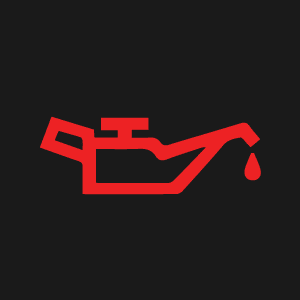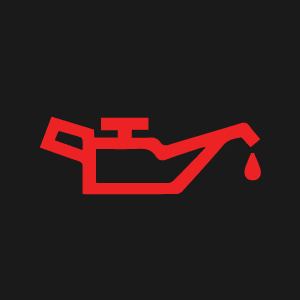The BMW E90 yellow oil light indicates low oil level or pressure, requiring immediate attention to prevent engine damage. Neglecting the warning light can lead to costly repairs or engine failure.
It’s crucial to address the issue promptly by checking oil levels and adding oil if necessary. Proper maintenance ensures the engine’s longevity and performance. Regularly monitoring oil levels and responding to warning lights promptly can prevent major mechanical issues and keep your BMW running smoothly.
Taking proactive steps to address the yellow oil light can save you from expensive repairs down the line. Remember, a well-maintained engine is a key to a reliable and efficient vehicle.
Decoding The Bmw E90 Yellow Oil Light
When the BMW E90 yellow oil light appears, it indicates either high oil temperature, low oil level, or pressure issues. Addressing this promptly is crucial to prevent potential engine damage. It’s advisable to stop driving and check the oil level immediately to avoid any further complications.
The Meaning Behind The Illumination
The BMW E90 yellow oil light serves as a crucial indicator of potential issues with your vehicle’s oil system. When this light illuminates, it signifies that the oil temperature is too high or that the oil level or pressure is insufficient. Ignoring this warning could lead to severe engine damage, making it imperative to address the issue promptly.
Yellow Vs. Red: Understanding The Urgency
Typically, a red oil light demands immediate attention, signaling a more urgent problem, whereas the yellow oil light indicates a less severe issue that still requires prompt action. Despite the distinction, it’s crucial to address both red and yellow oil lights promptly to prevent potential damage to the engine.

Credit: m.youtube.com
Common Causes For The Yellow Oil Light Activation
When the BMW E90 yellow oil light activates, it indicates potential issues with oil temperature, level, or pressure. Ignoring this warning could result in costly engine damage, emphasizing the importance of prompt attention. Be sure to address the root cause promptly to avoid further complications.
Low Oil Level: The Primary Suspect
One of the most common reasons for the activation of the yellow oil light in your BMW E90 is low oil level. This is the primary suspect to consider when the light turns on. The yellow oil light is designed to warn you when the oil level is too low and needs to be refilled immediately. If you ignore this warning and continue driving your vehicle, it could lead to severe engine damage and costly repairs. Therefore, always make sure to check your oil level regularly and add oil as soon as possible if it’s running low.Oil Temperature And Pressure Concerns
Another reason why the yellow oil light may turn on is when the oil temperature gets too high or when the oil pressure is too low. When the oil temperature is too high, it means that the oil is not effectively lubricating the engine, which can lead to engine damage over time. On the other hand, when the oil pressure is too low, it could mean that there is a leak in the oil system or a malfunctioning oil pump. In either case, it’s crucial to address the issue as soon as possible to prevent further damage to your vehicle. In conclusion, the yellow oil light in your BMW E90 is a crucial warning sign that should never be ignored. Always take immediate action when you see this light turn on, whether it’s adding more oil, checking the oil level, or having a professional mechanic inspect your vehicle. By doing so, you can ensure the longevity and reliability of your BMW E90.The Immediate Steps To Take When The Light Comes On
The Immediate Steps to Take When the Light Comes On
Checking The Oil Level: A First Aid
When the yellow oil light illuminates on your BMW E90, it indicates potential issues with oil temperature, level, or pressure. To address this promptly:
- Stop your vehicle in a safe location.
- Turn off the engine and let it cool down.
- Locate the oil dipstick in the engine bay.
- Remove the dipstick, wipe it clean, reinsert, and then pull it out to check the oil level.
- If the oil level is low, add the appropriate type of oil as per your vehicle’s specifications.
When To Shut Off The Engine
If you notice the yellow oil light and experience any of the following, it’s crucial to shut off the engine immediately:
- Engine noise or knocking sounds: Indicative of insufficient lubrication due to low oil.
- Burning smell or smoke: Signifying potential overheating or oil leakage.
- Loss of power or performance: Suggesting engine issues that need attention.
By taking these immediate steps, you can prevent further damage to your BMW E90’s engine and ensure a safer driving experience.
Troubleshooting The Oil Level Sensor
When the yellow oil light illuminates on your BMW E90, it can be an alarming sight. This warning light typically indicates issues with oil temperature, level, or pressure, and it’s crucial to address these concerns promptly to prevent potential engine damage. In this section, we will explore the troubleshooting process for the oil level sensor, a critical component in ensuring proper oil management in your vehicle.
Sensor Location And Function
The oil level sensor in the BMW E90 is located in the oil pan. It is responsible for monitoring the oil level and relaying this information to the vehicle’s computer system. The sensor utilizes a float mechanism that moves with the oil level, sending signals to the dashboard indicator when the oil level becomes too low.
Symptoms Of A Faulty Oil Sensor
A faulty oil level sensor can lead to erroneous readings and trigger the yellow oil light on your dashboard. Some common symptoms of a faulty oil sensor include:
- Constant illumination of the yellow oil light, even after adding sufficient oil.
- Inaccurate oil level readings displayed on the dashboard.
- Intermittent or sporadic activation of the yellow oil light, despite consistent oil levels.
If you encounter any of these signs, it’s essential to inspect the oil level sensor to determine if it requires repair or replacement.
Diy Tips: Checking And Replacing The Oil Sensor
DIY Tips: Checking and Replacing the Oil Sensor
Tools Required For The Job
Before starting the oil sensor replacement process, it’s essential to have the right tools at hand. Here is a list of the tools you will need:
- Socket wrench set
- Oil filter wrench
- Oil drain pan
- New oil sensor
- Rubber gloves
- Safety goggles
- Ratchet
- Shop towels
Step-by-step Sensor Replacement Guide
Follow these step-by-step instructions to replace the oil sensor in your BMW E90:
- Locate the oil sensor: The oil sensor is typically located on the bottom of the engine oil pan. It may be necessary to raise the vehicle to access it.
- Drain the oil: Place the oil drain pan beneath the oil pan, then use the socket wrench set to remove the drain plug and drain the oil into the pan.
- Remove the old sensor: Use the oil filter wrench to carefully remove the old oil sensor from the oil pan. Be sure to have the shop towels handy to clean up any oil spills.
- Install the new sensor: Carefully install the new oil sensor into the oil pan, ensuring it is securely in place and properly sealed.
- Refill the oil: Once the new sensor is installed, refill the engine with the appropriate amount of oil and replace the drain plug.
- Reset the warning light: Start the engine and ensure that the oil warning light is no longer illuminated. If it is still on, consult the vehicle manual or a professional for further assistance.

Credit: www.reddit.com
Understanding Oil Leaks And Their Role
The BMW E90 yellow oil light indicates low oil level or pressure, crucial for engine lubrication. Prompt action is essential to prevent costly damage. Shut off the engine immediately and check oil levels to ensure optimal engine performance and longevity.
Understanding Oil Leaks and Their Role Worn Oil Filter Issues An old oil filter can lead to leaks, reducing engine lubrication. Regularly replacing the filter is crucial. The Impact of an Incorrectly Sealed Drain Plug If the drain plug is not sealed correctly, oil can leak, causing low oil levels and potential engine damage. Double-checking the seal is essential.The Risks Of Driving With The Yellow Oil Light On
Driving with the yellow oil light on in a BMW E90 could indicate low oil level or pressure. Ignoring this warning may lead to severe engine damage. It’s crucial to address the issue promptly to prevent costly repairs.
The Risks of Driving with the Yellow Oil Light On The yellow oil light on your BMW is not something you should ignore. It’s a warning that something is wrong with your engine oil, and driving with this warning light on can lead to serious consequences. In this section, we’ll explore the potential risks of driving with the yellow oil light on, including engine damage and safety and longevity considerations.Potential Engine Damage
The oil in your engine has two primary functions: lubrication and cooling. If the oil level or pressure is low, it means that your engine is not being lubricated effectively, which can lead to increased friction and heat. Over time, this can cause significant damage to your engine, including worn bearings, warped cylinder walls, and even engine failure.Safety And Longevity Considerations
Driving with the yellow oil light on can also affect your safety and the longevity of your vehicle. If your engine oil is not lubricating the engine properly, it can cause the engine to overheat, which can lead to a breakdown or even a fire. Additionally, driving with low oil pressure or level can cause premature wear and tear on your engine, shortening its lifespan and increasing the likelihood of expensive repairs. In conclusion, it’s essential to take the yellow oil light warning seriously and act quickly to resolve the issue. If you notice this warning light on, it’s best to find a safe place to stop and have your car checked out by a qualified mechanic. This simple step can save you time, money, and potentially even your safety.Credit: www.e90post.com
Professional Vs. Diy: When To Call The Experts
When it comes to addressing the yellow oil light in your BMW E90, it’s crucial to consider whether to handle the issue yourself or seek professional assistance. Knowing when to call the experts can prevent potential risks and ensure the problem is effectively resolved.
Evaluating The Severity Of The Issue
Upon encountering the yellow oil light in your BMW E90, it’s essential to assess the severity of the situation before taking any action. This includes checking the oil level, inspecting for leaks, and considering any unusual engine noises or performance issues. If you lack the necessary expertise or tools to perform a comprehensive evaluation, it may be best to seek professional assistance.
Benefits Of Professional Assessment
Engaging professional assistance for the yellow oil light concern in your BMW E90 offers several advantages. Qualified technicians possess the expertise, diagnostic tools, and experience to accurately identify the root cause of the issue. Their assessment can help prevent potential engine damage and ensure that the necessary repairs are carried out effectively, ultimately saving you time and money in the long run.
Maintaining Your Bmw E90’s Oil Health
Regular maintenance of your BMW E90’s oil health is crucial for ensuring optimal engine performance and longevity. One of the most important aspects of this maintenance is keeping an eye on the yellow oil light, which indicates potential issues with oil temperature, level, or pressure. By understanding the significance of this warning and taking proactive measures, you can safeguard your BMW’s engine from costly damage.
Regular Oil Checks And Changes
Regularly checking your BMW E90’s oil level and condition is essential for preventing potential engine problems. It’s recommended to check the oil level at least once a month and before long trips. Additionally, adhere to the manufacturer’s guidelines for oil change intervals to ensure that the engine is consistently supplied with clean and sufficient oil.
Choosing The Right Oil For Your Bmw
When selecting oil for your BMW E90, opt for products that meet the manufacturer’s specifications to ensure compatibility and optimal performance. Consult the owner’s manual or seek advice from a qualified mechanic to determine the most suitable oil viscosity and type for your specific BMW model.
Frequently Asked Questions
What Does Yellow Oil Light Mean On Bmw?
The yellow oil light on a BMW indicates high oil temperature, low oil level, or low oil pressure. Driving with this light on can cause expensive engine damage, so it’s best to stop and check the oil level or have the car inspected.
Can You Drive With A Yellow Oil Light?
Driving with a yellow oil light is not advisable. Stop and have your car checked to avoid engine damage.
Why Does My Bmw Oil Light Come On?
The BMW yellow oil warning light comes on when the oil temperature is too high or the oil level/pressure is too low. It’s important to act quickly as low oil lubrication can cause expensive and irreparable engine damage. It’s not advisable to drive with the oil light on for an extended period, and it’s best to stop and have your car checked out.
Leaking oil can be caused by a worn oil filter or incorrectly sealed drain plug.
What Is The Difference Between Yellow And Red Oil Light?
The red oil light signals immediate action required, while yellow indicates a less urgent issue.
Conclusion
Understanding the significance of the BMW E90 yellow oil light is crucial. Ignoring it could lead to costly engine damage. It’s best to address the issue promptly and ensure proper oil levels to maintain your BMW’s performance and longevity. Stay informed and proactive for a smooth driving experience.


